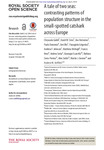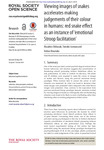Search
Now showing items 1-10 of 144
Can outcomes of dyadic interactions be consistent across contexts amongwild zebrafish?
(The Royal Society, 2015)
Winner–loser relations among group-living individuals are often measured by the levels of aggressive interactions between them. These interactions are typically driven by competition for resources such as food and mates. ...
A tale of two seas
(2014)
Elasmobranchs represent important components of marine ecosystems, but they can be vulnerable to overexploitation. This has driven investigations into the population genetic structure of large-bodied pelagic sharks, but ...
Self motion facilitates echo acoustic orientation in humans
(2014)
The ability of blind humans to navigate complex environments through echolocation has received rapidly increasing scientific interest. However, technical limitations have precluded a formal quantification of the interplay ...
Viewing images of snakes accelerates making judgements of their colour in humans
(2014)
One of the most prevalent current psychobiological notions about human behaviour and emotion suggests that prioritization of threatening stimuli processing induces deleterious effects on task performance. In order to confirm ...
Strong biomechanical constraints on young children’s mental imagery of hands
(2014)
Mental rotation (MR) of body parts is a useful paradigm to investigate how people manipulate mental imagery related to body schema. It has been documented that adult participants use ‘motor imagery’ for MR of hands: a ...
Repeatability in the contact calling systemof Spix’s disc winged bat
(2015)
Spix’s disc-winged bat (Thyroptera tricolor) forms cohesive groups despite using an extremely ephemeral roost, partly due to the use of two acoustic signals that help individuals locate roost sites and group members. While ...
Light-emitting diode street lights reduce last-ditch evasivemanoeuvres by moths to bat echolocation calls
(The Royal Society, 2015)
The light-emitting diode (LED) street light market is expanding globally, and it is important to understand how LED lights affect wildlife populations. We compared evasive flight responses of moths to bat echolocation calls ...
Discrete but variable structure of animal societies leads to the false perception of a social continuum
(2016)
Animal societies are typically divided into those in which reproduction within a group is monopolized by a single female versus those in which it is shared among multiple females. It remains controversial, however, whether ...
Artificial light onwater attracts turtle hatchlings during their near shore transit
(2016)
We examined the effect of artificial light on the near shore trajectories of turtle hatchlings dispersing from natal beaches. Green turtle (Chelonia mydas) hatchlings were tagged with miniature acoustic transmitters and ...
Responsiveness to conspecific distress calls is influenced by day roost proximity in bats
(2016)
Distress calls signal extreme physical distress, e.g. being caught by a predator. In many bat species, distress calls attract conspecifics. Because bats often occupy perennial day-roosts, they might adapt their responsiveness ...










